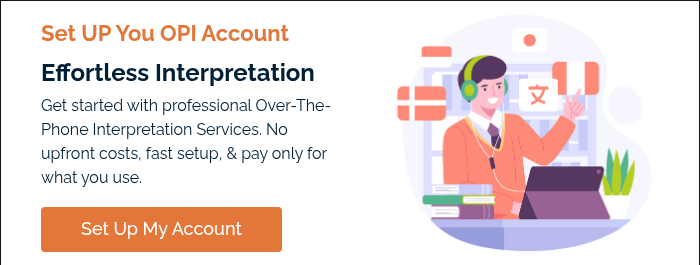What is Over-The-Phone Interpretation And How Does it Work?

There are times when you’ll need to have a phone call with a foreign client or partner interpreted.
This should be simple, but where do you turn to get the simple questions answered?
How much notice is needed? Do you need additional technology? Where do you source an interpreter that knows English and Bengali? Does an interpreter need to be in the room with you?
At LinguaLinx, we hear these concerns all the time, and they are completely legitimate when you don’t know the process. If you get the right Language Services Provider (LSP) to help you, they’ll make sure everything runs smoothly.
In this article, we’ll arm you with a bit of knowledge (and hopefully alleviate some fears) about over-the-phone interpretation services.
It's Not Just About the Phone
One of the big business communications changes that arose out of the COVID-19 pandemic was the increased use of remote meetings.
With the advent of technology, global meetings have become commonplace. Microsoft Teams, Zoom, Google Hangout and Skype have made it easy for everyone to attend meetings - no matter where they are in the world.
No longer a rarity, staying connected is now expected and with just a few clicks, you can be part of the conversation.
As a meeting device, the phone is pretty much a dinosaur in our digital world. However, it’s still known as telephone interpretation even though it applies to any web-based platform, not just the phoneosauraus rex.
How Does Over-The-Phone Interpretation Work?
Over-the-phone interpretation is pretty simple. You have two people on a call, each speaking different languages, and a third neutral person who speaks both languages to interpret the conversation.
If there are more than two people, then there may be provision for each speaker to use a buzzer, or some kind of signal, to indicate when they’ve finished speaking; like saying “over” on walkie-talkies.
Technology And Process
Different LSPs might have a slightly different way of working, but it’ll usually come down to something like this:
- You call a provided phone number at a pre-arranged time
- You enter a password or numeric code
- You get onto the call with both your interpreter and the other member of the call
Planning Helps
In most cases, for over-the-phone interpretation, a language service provider will be able to connect you fairly quickly with a qualified interpreter.
However, if you need interpretation into a rare language, you'll want to give a little more advanced notice. Doing so allows the LSP to line up an interpreter who not only speaks both languages but also has experience in your industry. They’ll know the nuances of how the industry works, the terminology used, and the tone of communication in that field.
If you’re talking about a new advertising campaign for Nike, or a patent for the next level of nuclear fuel generation, the tone of voice will be quite different. We always suggest having someone with industry experience to ensure the relevance of the interpretation.
On-Demand Over-The-Phone Interpretation
This is the real world. Sometimes you don’t have a few days to plan a call. It has to happen ASAP. On-Demand telephone interpretation is a service where you can immediately be connected with an interpreter when you suddenly need it.
The reality is that there may be a small delay, while the necessary interpreter is lined up, and depending on the complexity of the language, but it keeps your business operating as fast as possible.
What Determines Interpretation Rates?
It would be great to simply say telephone interpretation costs X, but the reality is, as in all interpretation and translation, there are factors that affect OPI costs.
How rare is the language? There are a lot more English to Spanish interpreters than there are English to Icelandic.
What’s the language? While not rare, Arabic, Chinese, and Japanese have a level of complication to them that make them more expensive.
How quickly do you need it? There’s usually a premium to pay for On-Demand interpretation because it requires interpreters to essentially be “on-call.”
What’s your industry? As we said, getting an interpreter with industry experience is important. Certain industries such as financial services and technology, are more expensive than others.
How frequently do you need it? If you only need the services occasionally, it would make sense to purchase the interpretation as the need arises. But if you’ve just signed a new client in Germany and are going to be speaking on a weekly basis, then LSPs tend to offer a subscription price which is more cost effective.
Keep It Simple
Trying to interpret a foreign language during a crucial business call can be a daunting task, especially if you are not an expert in the language. You may have the right tools, but do you know how to use them? And what if something goes wrong during the call? It's like servicing your own car without proper training; you may end up with more problems than you started with.
That's where a good Language Services Provider (LSP) comes in. With their expertise, an experienced LSP can ensure that the interpretation process runs smoothly, leaving you with one less thing to worry about. By giving them as much notice as possible, they can even source an interpreter who has experience in your industry and understands the nuances and technical jargon.
So, why risk a potentially disastrous call when you can work with an LSP and get back to running your business? With their help, you can communicate effectively with your foreign clients or partners without any language barriers. It's that simple.
Get A Quote For Your Telephone Interpretation Needs
Don't let language barriers hold you back from successful international communication. LinguaLinx offers top-notch telephone interpretation services with no risk or commitment.
Our experienced interpreters ensure that your message is accurately conveyed, and with our ISO 17100 compliance and extensive professional translation background, you can trust that your business is in good hands.
Contact us today for a free consultation on how we can help you bridge the language gap.






